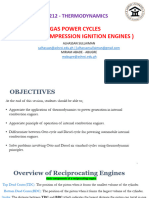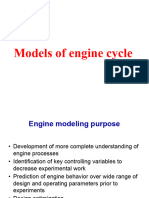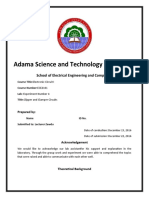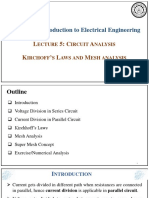0 ratings0% found this document useful (0 votes)
14 views2engine Cycle
2engine Cycle
Uploaded by
eyobThe document describes the ideal Otto cycle used to model the thermodynamic processes in a spark-ignition internal combustion engine. The Otto cycle approximates the actual engine cycle by treating the gas as air, closing the system, replacing combustion with constant-volume heat addition, and modeling the processes as reversible and isentropic or constant-volume/pressure. This simplified model allows easier analysis of the engine cycle compared to the real open system with changing gas composition.
Copyright:
© All Rights Reserved
Available Formats
Download as PDF, TXT or read online from Scribd
2engine Cycle
2engine Cycle
Uploaded by
eyob0 ratings0% found this document useful (0 votes)
14 views35 pagesThe document describes the ideal Otto cycle used to model the thermodynamic processes in a spark-ignition internal combustion engine. The Otto cycle approximates the actual engine cycle by treating the gas as air, closing the system, replacing combustion with constant-volume heat addition, and modeling the processes as reversible and isentropic or constant-volume/pressure. This simplified model allows easier analysis of the engine cycle compared to the real open system with changing gas composition.
Original Description:
engine
Original Title
2engine_cycle
Copyright
© © All Rights Reserved
Available Formats
PDF, TXT or read online from Scribd
Share this document
Did you find this document useful?
Is this content inappropriate?
The document describes the ideal Otto cycle used to model the thermodynamic processes in a spark-ignition internal combustion engine. The Otto cycle approximates the actual engine cycle by treating the gas as air, closing the system, replacing combustion with constant-volume heat addition, and modeling the processes as reversible and isentropic or constant-volume/pressure. This simplified model allows easier analysis of the engine cycle compared to the real open system with changing gas composition.
Copyright:
© All Rights Reserved
Available Formats
Download as PDF, TXT or read online from Scribd
Download as pdf or txt
0 ratings0% found this document useful (0 votes)
14 views35 pages2engine Cycle
2engine Cycle
Uploaded by
eyobThe document describes the ideal Otto cycle used to model the thermodynamic processes in a spark-ignition internal combustion engine. The Otto cycle approximates the actual engine cycle by treating the gas as air, closing the system, replacing combustion with constant-volume heat addition, and modeling the processes as reversible and isentropic or constant-volume/pressure. This simplified model allows easier analysis of the engine cycle compared to the real open system with changing gas composition.
Copyright:
© All Rights Reserved
Available Formats
Download as PDF, TXT or read online from Scribd
Download as pdf or txt
You are on page 1of 35
Engine Cycles
• IC Engine combustion is an open cycle with
changing composition, a difficult system to
analyze.
• To make the analysis of the engine cycle much
more easy, the real cycle is approximated with
an ideal air-standard cycle which differs from the
actual by the following:
…Engine Cycles`
1. The gas mixture in the cylinder is treated as air
for the entire cycle, and property values of air
are used in the analysis.
2. The real open cycle is changed into a closed
cycle by assuming that the gases being
exhausted are fed back into the intake system.
3. The combustion process is replaced with a heat
addition term Qin of equal energy value. Air alone
cannot combust.
…Engine Cycles
4. The open exhaust process, which carries a
large amount of enthalpy out of the system, is
replaced with a closed system heat rejection
process Qout of equal energy value.
5. Actual engine processes are approximated
with ideal processes.
(a) The almost-constant-pressure intake and
exhaust strokes are assumed to be
constant pressure.
…Engine Cycles
(b) Compression strokes and expansion strokes are
approximated by isentropic processes.
• To be truly isentropic would require these strokes
to be reversible and adiabatic.
(c) The combustion process is idealized by a
constant-volume process (SI cycle), a constant-
pressure process (CI cycle), or a combination of
both (CI Dual cycle).
(d) Exhaust blowdown is approximated by a
constant-volume process.
(e) All processes are considered reversible.
In air-standard cycles, air is considered an ideal gas such that the following
ideal gas relationships can be used:
…Engine Cycles
…Engine Cycles
• For thermodynamic analysis the specific heats of air
can be treated as functions of temperature, which
they are, or they can be treated as constants, which
simplifies calculations at a slight loss of accuracy.
• Constant specific heat analysis will be used, because
of the large temperature range experienced during
an engine cycle, the specific heats and ratio of
specific heats k do vary by a fair amount.
At the low temperature end of a cycle during intake and start
of compression, a value of k=1.4 is correct. However, at the
end of combustion the temperature has risen and the value of
k=1.3 is more accurate.
Air flow before it enters an engine is usually closer to
standard temperature and for these conditions a value
of k=1.4
3-2 OTTO CYCLE
• The cycle of a four-stroke, SI, naturally
aspirated engine at WOT.
• The intake stroke of the Otto cycle starts with
the piston at TDC and is a constant-pressure
process at an inlet pressure of one
atmosphere (process 6-1 in Fig.3-1).
…OTTO CYCLE
• The second stroke of the cycle is the
compression stroke, which in the Otto cycle is
an isentropic compression from BDC to TDC
(process 1-2).
• This is a good approximation to compression
in a real engine, except for the very beginning
and the very end of the stroke.
…OTTO CYCLE
• The compression stroke is followed by a constant-
volume heat input process 2-3 at TDC.
• This replaces the combustion process of the real
engine cycle, which occurs at close to constant
volume conditions.
• During combustion or heat input, a large amount
of energy is added to the air within the cylinder.
This energy raises the temperature of the air to
very high values, giving peak cycle temperature at
point 3.
…OTTO CYCLE
…OTTO CYCLE
• The very high pressure and enthalpy values
within the system at TDC generate the power
stroke (or expansion stroke) which follows
combustion (process 3-4).
• High pressure on the piston face forces the piston
back towards BDC and produces the work and
power output of the engine.
• During the power stroke, values of both the
temperature and pressure within the cylinder
decrease as volume increases from TDC to BDC.
…OTTO CYCLE
• Near the end of the power stroke of a real
engine cycle, the exhaust valve is opened and
the cylinder experiences exhaust blow down.
• A large amount of exhaust gas is expelled from
the cylinder, reducing the pressure to that of
the exhaust manifold.
• A large quantity of enthalpy is carried away
with the exhaust gases, limiting the thermal
efficiency of the engine.
…OTTO CYCLE
• The Otto cycle replaces the exhaust blow down
open system process of the real cycle with a
constant-volume pressure reduction, closed-
system process 4-5.
• Enthalpy loss during this process is replaced
with heat rejection in the engine analysis.
• Pressure within the cylinder at the end of
exhaust blowdown has been reduced to about
one atmosphere,
…OTTO CYCLE
• Process 5-6 is the exhaust stroke that occurs at
a constant pressure of one atmosphere due to
the open exhaust valve.
• This is a good approximation to the real
exhaust stroke, which occurs at a pressure
slightly higher than the surrounding pressure
due to the small pressure drop across the
exhaust valve and in the exhaust system.
…Process 1-2
Solution:
You might also like
- Lab 3 - Zener Diode Voltage RegulationDocument11 pagesLab 3 - Zener Diode Voltage Regulationeyob100% (1)
- Lecture 3-IC Engines-Cycles PDFDocument38 pagesLecture 3-IC Engines-Cycles PDFFelipe Barsanufio Pereira100% (2)
- Engine Cycles (Otto)Document21 pagesEngine Cycles (Otto)osama.ammer2002No ratings yet
- Chapter 3 Summary - Andrew AymanDocument30 pagesChapter 3 Summary - Andrew Aymanbg41255No ratings yet
- Kuliah - 02 Teknik KendaraanDocument61 pagesKuliah - 02 Teknik Kendaraananthony martialNo ratings yet
- Module 3 - Ideal Models of Engine CyclesDocument37 pagesModule 3 - Ideal Models of Engine CyclesMuhammad BilalNo ratings yet
- L 1 Gas Power Cycle 1Document77 pagesL 1 Gas Power Cycle 1De Jose Niño VonNo ratings yet
- Course 4 Engine CyclesDocument53 pagesCourse 4 Engine CyclesLuca PenesNo ratings yet
- Teoria y Problemas PulkrabeckDocument53 pagesTeoria y Problemas Pulkrabeckpaula daniela rincón garcíaNo ratings yet
- I C EngineDocument53 pagesI C EngineYogesh K BoharaNo ratings yet
- ATD Unit 1Document39 pagesATD Unit 1Sateesh KumarNo ratings yet
- CH-3, Engine CyclesDocument79 pagesCH-3, Engine CyclesIsmail AsifNo ratings yet
- A. Otto Cycle (Gasoline Engine)Document22 pagesA. Otto Cycle (Gasoline Engine)John Manuel BautistaNo ratings yet
- Analysis of Gas Power CyclesDocument8 pagesAnalysis of Gas Power CyclesPradeep SandhalNo ratings yet
- Actual Fuel-Air Cycles PDFDocument28 pagesActual Fuel-Air Cycles PDFanup chauhanNo ratings yet
- Chapter5internalcombustionengine 150613191033 Lva1 App6891Document53 pagesChapter5internalcombustionengine 150613191033 Lva1 App6891MatnSambuNo ratings yet
- Theoretical CyclesDocument56 pagesTheoretical CyclesADOBONo ratings yet
- 8 ME212 Gaspowercycles (SI CIengines)Document19 pages8 ME212 Gaspowercycles (SI CIengines)mosesdayesNo ratings yet
- Thermodynamics - Chapter 5Document15 pagesThermodynamics - Chapter 5LiyanaNo ratings yet
- UNIT 8 ThermodynamicsDocument9 pagesUNIT 8 ThermodynamicsHimadhar SaduNo ratings yet
- 04 IC Engines Chapter 3Document30 pages04 IC Engines Chapter 3Ahsan AliNo ratings yet
- Internal Combustion EngineDocument54 pagesInternal Combustion EngineBagas Satriya PrayogaNo ratings yet
- LEC# 06. Petrol, Diesel, Rankine, Brayton CyclesDocument33 pagesLEC# 06. Petrol, Diesel, Rankine, Brayton CyclesAns ahmedNo ratings yet
- MEng3102 Chapter 2Document31 pagesMEng3102 Chapter 2Hinsermu NeftalemNo ratings yet
- Materi - Otto CycleDocument21 pagesMateri - Otto CycleRydho Putra PradanaNo ratings yet
- Chapter TwoDocument80 pagesChapter TwobroNo ratings yet
- Chapter-1 Thermodynamics CycleDocument37 pagesChapter-1 Thermodynamics CycleNavin JhaNo ratings yet
- Lecture 8 Engine Cycles - OttoDocument42 pagesLecture 8 Engine Cycles - OttoMuhammad AbubakarNo ratings yet
- Gas Power CyclesDocument7 pagesGas Power CyclesLegenGaryNo ratings yet
- IC Engines Chapter 3 PDFDocument28 pagesIC Engines Chapter 3 PDFnauman khanNo ratings yet
- ATD Unit 3.1Document18 pagesATD Unit 3.1Mr. P. Ramkumar MECHNo ratings yet
- LEC - OTTO - 1 - Microsoft - Office - PowerPoint - Presentation - PPTX Filename - UTF-8''Document35 pagesLEC - OTTO - 1 - Microsoft - Office - PowerPoint - Presentation - PPTX Filename - UTF-8''engineeringNo ratings yet
- Thermodynamic of IC EnginesDocument16 pagesThermodynamic of IC EnginesZemariam GetuNo ratings yet
- Gas Power Cycles: Chapter FiveDocument46 pagesGas Power Cycles: Chapter FivenunuNo ratings yet
- 1.2 Actual CyclesDocument51 pages1.2 Actual CyclesAniket 19SB18No ratings yet
- Chapter 2 Engine Operating CyclesDocument22 pagesChapter 2 Engine Operating CyclesYeet server YesNo ratings yet
- Models of Engine CyclesDocument39 pagesModels of Engine Cyclesakibmahmud392No ratings yet
- TermodinamikaDocument35 pagesTermodinamikaaji wiranegaraNo ratings yet
- Thermodynamic of IC EnginesDocument16 pagesThermodynamic of IC EnginesteddiyfentawNo ratings yet
- En601 Foundation For Energy EngineeringDocument10 pagesEn601 Foundation For Energy EngineeringJAMI PRUDHVI RAJNo ratings yet
- Engine: An Engine Is Motor Which Converts Chemical Energy of A Fuel Into The Mechanical EnergyDocument61 pagesEngine: An Engine Is Motor Which Converts Chemical Energy of A Fuel Into The Mechanical EnergyZain Ul AbideenNo ratings yet
- Unit I - Gas Power Cycles: Department of Mechanical EngineeringDocument15 pagesUnit I - Gas Power Cycles: Department of Mechanical EngineeringpvrbalaNo ratings yet
- Chapter 09 - Gas Power CyclesDocument102 pagesChapter 09 - Gas Power Cyclesmo.dmour22No ratings yet
- UNIT I Gas Power Cycles FinalDocument75 pagesUNIT I Gas Power Cycles FinalMAYUR BHOSALENo ratings yet
- Chapter 9 LectureDocument29 pagesChapter 9 Lectureinam vf100% (6)
- Gas Power Cycles: Lecture # 9Document10 pagesGas Power Cycles: Lecture # 9zabidullahNo ratings yet
- Lec9 PDFDocument34 pagesLec9 PDFshravanNo ratings yet
- Lecture 4 GAS Power CyclesDocument76 pagesLecture 4 GAS Power Cyclesjackson mathiasNo ratings yet
- Ic Engine Thermo Dynamics of Ic EngineDocument26 pagesIc Engine Thermo Dynamics of Ic EngineNaol EmanaNo ratings yet
- BAB IX GAS POWER CYCLES - Part 1Document62 pagesBAB IX GAS POWER CYCLES - Part 1Septia IndahsariNo ratings yet
- Air Standard CycleDocument93 pagesAir Standard CycleJonathan CerdanNo ratings yet
- Reversible and Irreversible ProcessesDocument24 pagesReversible and Irreversible ProcessesShootingStarPhotonsNo ratings yet
- Sol - 9 - Me3310 - Air Standard CyclesDocument39 pagesSol - 9 - Me3310 - Air Standard CyclesRenjith SinghNo ratings yet
- Different Cycle of IC EngineDocument13 pagesDifferent Cycle of IC EngineTaslim AminNo ratings yet
- CH 3Document33 pagesCH 3beila.amu.22No ratings yet
- Chapter 4 Air Refrigeration SystemsDocument31 pagesChapter 4 Air Refrigeration Systemsmahatojitendrakumar123No ratings yet
- Stirling & Ericsson CyclesDocument9 pagesStirling & Ericsson CyclesAntônio GoulartNo ratings yet
- Gas Power CycleDocument42 pagesGas Power CycleAdrianNo ratings yet
- Chapter-1 Lecture NoteDocument22 pagesChapter-1 Lecture NoteeyobNo ratings yet
- CH 4. VGas Power CycleDocument14 pagesCH 4. VGas Power CycleeyobNo ratings yet
- CH 3.1. Gas Power Cycle (Otto & Diesel)Document27 pagesCH 3.1. Gas Power Cycle (Otto & Diesel)eyobNo ratings yet
- CH 3.2. Gas Power CycleDocument11 pagesCH 3.2. Gas Power CycleeyobNo ratings yet
- Lab 3 - DC Circuit AnalysisDocument7 pagesLab 3 - DC Circuit AnalysiseyobNo ratings yet
- 4gasoline Fuel SystemDocument56 pages4gasoline Fuel SystemeyobNo ratings yet
- AbogidaDocument1 pageAbogidaeyobNo ratings yet
- Lab 4 - Clippper and Clamper CircuitsDocument7 pagesLab 4 - Clippper and Clamper CircuitseyobNo ratings yet
- 1diesel Fuel SystemDocument40 pages1diesel Fuel SystemeyobNo ratings yet
- Work Sheet I & IIDocument17 pagesWork Sheet I & IIeyobNo ratings yet
- Current DivisionDocument62 pagesCurrent DivisioneyobNo ratings yet
- Chapter IDocument37 pagesChapter IeyobNo ratings yet
- Lab 5 - Votage Multilpier CircuitsDocument6 pagesLab 5 - Votage Multilpier CircuitseyobNo ratings yet
- Worksheet - 1 (MEng 2110)Document2 pagesWorksheet - 1 (MEng 2110)eyobNo ratings yet
- Worksheet 5Document2 pagesWorksheet 5eyobNo ratings yet
- Author - Docx C++ ProjectDocument10 pagesAuthor - Docx C++ ProjecteyobNo ratings yet
- Chapter 2 Lecture NoteDocument19 pagesChapter 2 Lecture NoteeyobNo ratings yet
- Work Sheet OneDocument7 pagesWork Sheet OneeyobNo ratings yet
- Major Contemporary Global AssignmentDocument2 pagesMajor Contemporary Global AssignmenteyobNo ratings yet
- The Highlighted Problems Are Assignment To Be Submitted .: Worksheet 6Document2 pagesThe Highlighted Problems Are Assignment To Be Submitted .: Worksheet 6eyobNo ratings yet
- Understanding IR and FPDocument88 pagesUnderstanding IR and FPeyobNo ratings yet
- Worksheet 4 Looking BackDocument3 pagesWorksheet 4 Looking BackeyobNo ratings yet
- Motivation, Emotion, and Stress and CopingDocument109 pagesMotivation, Emotion, and Stress and CopingeyobNo ratings yet
- Major Contemporary Global AssignmentDocument2 pagesMajor Contemporary Global AssignmenteyobNo ratings yet
- Major Contemporary Global IssuesDocument3 pagesMajor Contemporary Global IssueseyobNo ratings yet
- Chapter Five: Augmented Reality (AR)Document24 pagesChapter Five: Augmented Reality (AR)towfik sefaNo ratings yet
- Chapter Six: Ethics and Professionalism OF Emerging TechnologiesDocument20 pagesChapter Six: Ethics and Professionalism OF Emerging Technologieseyob67% (3)
- Objectives of This Chapter: Chapter 3: Learning and TheoriesDocument136 pagesObjectives of This Chapter: Chapter 3: Learning and TheorieseyobNo ratings yet
- Sentence Combination - ExercisesDocument11 pagesSentence Combination - ExerciseseyobNo ratings yet
























































































